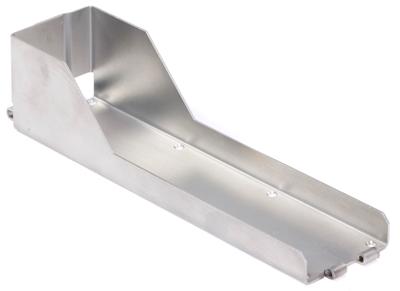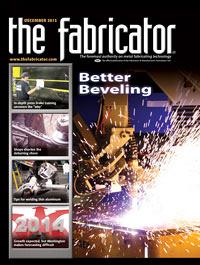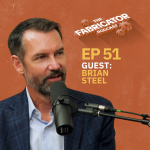Senior Editor
- FMA
- The Fabricator
- FABTECH
- Canadian Metalworking
Categories
- Additive Manufacturing
- Aluminum Welding
- Arc Welding
- Assembly and Joining
- Automation and Robotics
- Bending and Forming
- Consumables
- Cutting and Weld Prep
- Electric Vehicles
- En Español
- Finishing
- Hydroforming
- Laser Cutting
- Laser Welding
- Machining
- Manufacturing Software
- Materials Handling
- Metals/Materials
- Oxyfuel Cutting
- Plasma Cutting
- Power Tools
- Punching and Other Holemaking
- Roll Forming
- Safety
- Sawing
- Shearing
- Shop Management
- Testing and Measuring
- Tube and Pipe Fabrication
- Tube and Pipe Production
- Waterjet Cutting
Industry Directory
Webcasts
Podcasts
FAB 40
Advertise
Subscribe
Account Login
Search
Hinging Success—on Hinges
How hinges turned a garage shop into a precision sheet metal fabricator
- By Tim Heston
- December 2, 2013
- Article
- Shop Management
Walk onto the shop floor at Midlake Products & Mfg. Co. and you’ll see lasers, turret punch presses, press brakes, and stamping presses. The Louisville, Ohio, contract precision sheet metal fabricator offers welding, as well as parts finishing. The floor is clean, and equipment and tools are labeled and organized. Tools and work-in-process aren’t strewn about. Employees are engaged andcheck the quality of their work.
Today—after a decade bookended by the dot-com bust and the Great Recession, events that purged many underperforming companies—this kind of operation isn’t unusual. But if you notice a collection of unusual press brake tools, you’ll see what sets this fabricator apart. It all hinges on, well, hinges.
The company has built up quite a collection of hinge tools after more than two dozen years of experience in the business. It’s an uncommon niche that for Midlake has served as a path for growth. Today the company still produces hinges, but it also fabricates the sheet metal parts that connect to those hinges, along with various other components and subassemblies.
The 65-employee company currently has more than 250 active customers and hundreds of jobs on the floor at any one time. It recently expanded its space by 20,000 square feet, and managers plan to use that space for more stamping presses and CNC machining. That’s a long way from a garage full of continuous hinges and a cutoff die—which essentially is what started it all.
The Road to Custom Work
President Jeff Rich remembers his father, Virgil, working in the hardware and hinge business, prodding his older brother to open his own shop. Much of the hinge market was, and still is, a commodity business. If you shop for a hinge in a catalog, chances are that hinge was made in large quantities with dedicated press tooling.
But what if you couldn’t find that hinge in a catalog? That question effectively launched Midlake Products & Mfg. Co. The business started as a simple cut-to-length operation—not for strip steel, but for continuous hinges, commonly called piano hinges. If a manufacturer needed a continuous hinge cut to a certain length, it would buy continuous hinges by the container and cut them to lengthusing a press with a cutoff die.
Local, small welding and fabrication shops didn’t have the volumes to justify making large purchases of continuous hinges, and this is where the Richs’ garage shop found its niche.
“We were more or less a distributor that cut the product to length and provided secondary operations,” Rich said.
They also built dies to form holes, notches, and other features, eliminating a process that their customers previously performed as a secondary operation. One of its earliest customers was in the marine industry, which is what inspired the company name. Many boats have horizontal stabilizers hinged to the back, and fabricating those hinges was Midlake.
Then in 1988 the brothers moved into their first dedicated manufacturing facility and started making their own hinges. The operation began with basic equipment: a mechanical shear, a few punch presses, and mechanical press brakes. An operator would cut a blank to size, then carry it to either a dedicated hinge-forming press (if volumes were high enough) or a press brake that had customhinge-making tools.

Figure 3: An integrated hinge eliminates the need to spot weld or otherwise attach a hinge later in assembly.
Soon the company began getting inquiries from larger companies. About six years later it invested in turret punch presses and, eventually, lasers. “That’s when things really started to develop for us,” Rich said, “and when we started to do work other than hinge manufacturing. We used to build so many stamping dies and other tools, and that drove our lead-times. And like today, we were dealingwith low- to mid-volume customers, so lead-times were always a challenge.”
The company has built up a wide selection of hinge tools for the press brake. When a new job comes in, there’s a good chance an existing brake tool can be used or modified to make that hinge.
Whether a hinge is made on a brake or with a stamping die, to create a knuckle requires more than one hit to curl the metal. On the brake, technicians usually use a two-hit die; in progressive stamping tooling, the curl may be made in three to five hits, depending on the design. Which operation does the job, the brake or progressive tooling, depends on the volume (see Figure 2). The company sells its ability to work with a customer on all stages of the product life cycle, fromprototype to production to aftermarket.
Still, the company focuses on the custom aspect of hinge-making, which is why you won’t see a hinge-form tool on the company’s turret punch press. “I know people who use those [punch press] hinge tools and have great success with them, but for the variety of customers we service, the different metals, curl and pin diameters we need to produce, it doesn’t seem to work with off-the-shelf turrettooling,” Rich said. “You really need to be able to make your own tooling for all the different metal thickness and pin diameter combinations we work with.”
Not Your Everyday Hinge
So what defines a “custom” hinge? As sources explained, it entails more than just a custom length. In Midlake’s market, the custom hinge can be integral to how a product works. Some require different leaf sizes, or have unique holes, notches, and bends that make it easier to attach it to an assembly.
It involves specific metal thicknesses and pin diameters, as well as unusual “operating arcs,” which determine how far the hinge opens. A standard continuous hinge might open 270 degrees, but a specialized hinge may be designed to open, say, 180 or 14 degrees. Sometimes the hinges have unique hardware installed, or torsion springs that affect how much force it takes to push or pull open.
Some are integrated directly into the finished product, with hinge knuckles formed onto the assembly itself (see Figure 3). This reduces the number of pieces in an assembly and eliminates the need to weld or otherwise attach the hinge.
Eliminating the need to attach the hinge also increases accuracy. There’s no chance of that hinge being spot welded in the wrong place because, well, there’s no spot welding. “And those joints can fail in the field, especially in a harsh environment,” said Greg Duplin, vice president of business development. “When you integrate it, that doesn’t happen.”
Of course, sometimes it does make sense to attach a hinge separately, for example, in a cosmetically important enclosure in which the designer wants to hide the hinge entirely. An integrated hinge will show its barrel—the curled metal wrapped around a pin—and this can’t be avoided unless the hinge is attached separately.
To design a custom hinge, Midlake engineers start with the metal thickness. As Rich explained, the hinge curl’s inside radius must be kept to no less than two times the material thickness, though a larger radius is preferable. So a hinge that’s 0.060 in. thick would have an inside radius of at least 0.125 in. And like in other press brake work, the minimum inside radius needs to be a littlebigger for thicker metal, especially for material that’s 0.25 in. thick.
“Most product designers don’t start by thinking about the hinge,” Duplin said. “When they try to buy a commodity hinge, they find that they can’t get a good fit, so when they work with us at the design stage, they really find that we can add a lot of value.”
When working on a prototype or first-run job, engineers talk with customers to see if basic hinge specs, including metal thickness and hinge diameter, match with available hinge-making tooling. “We’ve developed such a large inventory of curling tools over the years,” Rich said. “It’s not very often that we don’t have the available tooling to curl the material. If the metal and pin diametercombination matches, what that hinge looks like really doesn’t matter, as long as we have the curling tools in-house and ready to go. It can be as wide as they want. It can be different shapes and knockouts. It really doesn’t matter.”
For Midlake, this is where laser cutting really made its mark (see Figure 4). Nolonger did the company need to build a die for a specific hinge blank. Instead, the laser could cut that blank to any size and shape, with interior knockouts and other features.
Forming Expertise
“We have a lot of 15-year-plus employees who remember the days, myself included, of the old mechanical brakes with the rudimentary backgauging,” Rich said. “These veterans really know what it’s like to set up a brake, do shimming, and adjust the parameters.”
Of course, with modern hydraulic and electric press brakes, setup time has been reduced to a matter of minutes for many jobs, especially for hinge work. In fact, that’s where new press brake technicians start.
As Rich explained, the act of making a hinge is actually not terribly difficult for an operator with the right tooling. By the time the job goes to the floor, all the machine loads and minimum radii already have been determined. The operator sets up the tools, the ram comes down and forms half the curl in one hit and the rest of the curl on the next hit, and he has a finished hinge.
“After two decades of making hinges, we’ve taken a lot of the guesswork out of the operation,” Rich said. “Most of [the actual forming] is tightly controlled by the tooling. That’s why, for us, it’s probably the easiest operation we have.”
Rich added that this experience does, however, provide a good foundation for more complicated air-forming operations. Such jobs often have more than a dozen bends in which tolerance stackup (error in one bend affecting other bends), clearance problems, springback variation, and other challenges come into play.
Staying Away From the Catalog Market
At its core, the company remains a custom hinge manufacturer. “That’s why people come to us,” Rich said. “If you need a custom hinge, there aren’t really a lot of players that use the lasers and brakes the way we do. Once we have them as a customer, then we’re obviously interested in talking with them about what else they need. Can we incorporate a hinge right into a panel? Can we make theenclosure for you? Can we do the assembly for you? It’s not a new strategy, of course, but it has been working for us.”
About a decade ago, in an effort to increase revenue, Midlake made standard continuous and other “catalog” hinges. They invested significant money in capital equipment that pulled coil into an automated curling line that made 6-foot lengths of continuous hinge.
“That’s pretty standard stuff, and a lot of people make them,” said Duplin, “and most of them are in Asia now. We found that it was a commodity business and really couldn’t make money at it. So the focus returned to custom hinges, because it afforded a higher price point and a better opportunity to give customers exactly what they wanted.”
The company still provides continuous hinges, but it outsources the actual hinge-making, then adds holes, notches, and other features in-house. As in the past, today its sweet spot is in the low- to mid-volume arena, up to about 10,000 pieces a year, though the company does run a few jobs of higher volumes.
Sources said that concentrating on this niche—small to midsized jobs—has helped build a stable business. Duplin said it’s part of the reason that the Great Recession at Midlake wasn’t as bad as it could have been. The company did downsize, but it bounced back quickly during the recovery.
Years ago Midlake would get orders for tens of thousands of parts, and the customer paid for tools and put up with a long lead-time before going into production. “And a lot of times, customers didn’t sell the volumes that they thought they would,” Rich said. Now customers avoid the tooling investment and choose to have fewer hinges laser-cut and formed on a brake. Only after testing the watersdo they ramp up to higher volumes produced with dedicated tooling. “This is a hugely successful strategy for our customers. It really takes the burden off of their sales departments.”
The fabricator has transitioned from producing large volumes of small parts to smaller volumes of larger, often more complex assemblies. With high-mix production comes more complexity in part flow and scheduling, and like every other fabricator, Midlake’s lead-times have been squeezed. The company employs two Six Sigma black belts, one in quality assurance and another who heads operations.
And it has undergone 5S; the plant is well-lit, the floors are glossy gray, tools are labeled, part flow is easy to grasp. “We know it’s more than just looking good,” Duplin said. “We understand the benefits of reducing unneeded variability and downtime.”
But from a sales perspective, looking good helps. “Our price is competitive. But we tell our sales team, if you bring a customer into Midlake for a plant tour, we win that business 98 percent of the time, regardless of price,” Duplin said. “When we bring them in, they see it and they get it.”It’s certainly a long way from working in a garage, feeding piano hinges into a small cutoff press.
About the Author

Tim Heston
2135 Point Blvd
Elgin, IL 60123
815-381-1314
Tim Heston, The Fabricator's senior editor, has covered the metal fabrication industry since 1998, starting his career at the American Welding Society's Welding Journal. Since then he has covered the full range of metal fabrication processes, from stamping, bending, and cutting to grinding and polishing. He joined The Fabricator's staff in October 2007.
Related Companies
subscribe now

The Fabricator is North America's leading magazine for the metal forming and fabricating industry. The magazine delivers the news, technical articles, and case histories that enable fabricators to do their jobs more efficiently. The Fabricator has served the industry since 1970.
start your free subscription- Stay connected from anywhere

Easily access valuable industry resources now with full access to the digital edition of The Fabricator.

Easily access valuable industry resources now with full access to the digital edition of The Welder.

Easily access valuable industry resources now with full access to the digital edition of The Tube and Pipe Journal.
- Podcasting
- Podcast:
- The Fabricator Podcast
- Published:
- 04/09/2024
- Running Time:
- 63:55
In this podcast episode, Brian Steel, CEO of Cadrex Manufacturing, discusses the challenges of acquiring, merging, and integrating...
- Industry Events
16th Annual Safety Conference
- April 30 - May 1, 2024
- Elgin,
Pipe and Tube Conference
- May 21 - 22, 2024
- Omaha, NE
World-Class Roll Forming Workshop
- June 5 - 6, 2024
- Louisville, KY
Advanced Laser Application Workshop
- June 25 - 27, 2024
- Novi, MI
































